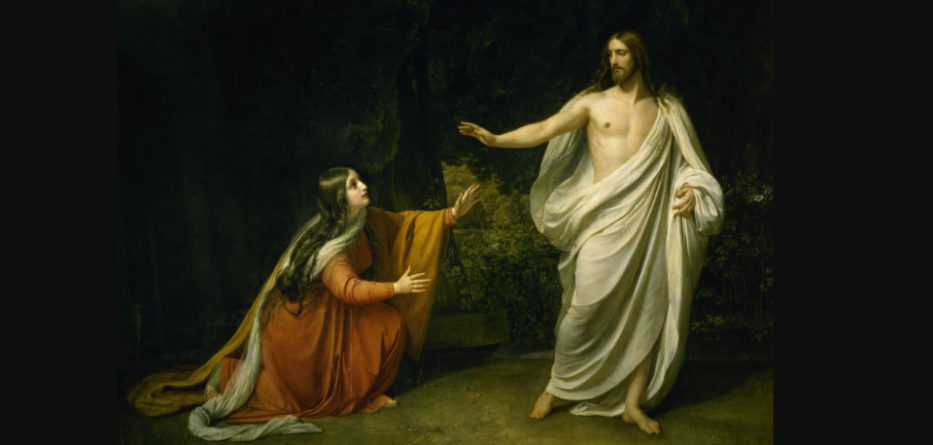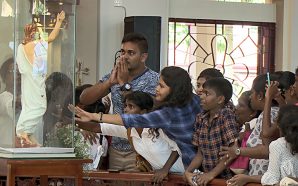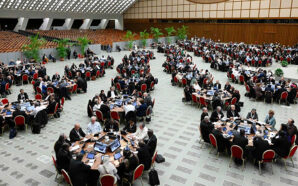With the flame of the Easter candle extinguished for the year, I slip in to the ordinary times of the Liturgical calendar, feeling renewed, bolstered by the ritual reminders of Jesus’ love and sacrifice; comforted and held by the clear sense of Church community that we experienced through the solemn ceremonies of Holy Week, and the triumphant soaring of the heart on Easter Sunday. And yet a niggle persists, zapping some life out of an otherwise wonderful Season, as I am reminded that the perspective of faith presented to us is essentially all male…
I often restrict my activity on Holy Saturday, keen to in some way meditate on what the followers of Jesus experienced on Good Friday and Holy Saturday: despair at the death of their friend and teacher, guilt and disappointment with their own actions, no doubt terror at any trial by association. Perhaps numbness would have followed the burial, as realisation of the significance of the day’s events seeped in. And then, deep loss. Loss of beloved Friend, loss of freedom, loss of purpose and identity, loss of hope. Perhaps the future appeared bleak, if not threatening. Even if they managed to survive the furore of the Roman army intent on sterilising the community of any remnant Christianity, there would be reputations to rebuild, family ties to restore. Did thoughts surface of the promise made by Jesus that He would rise on the third day? If so, they would likely have been quickly squashed, the disappointment should it not eventuate probably too great to bear straight after the day’s harrowing events.
What do the apostles think then when Mary Magdalene bursts in, claiming this very thing – she has seen the risen Lord. Or, more accurately, the Lord has shown Himself to her. Confusion, doubt, restrained excitement? Caution? After all, she was a woman, hardly seen as a credible witness in those times. Can she be trusted, could she simply be deranged with grief, hallucinating?
Yet Jesus chose to show Himself to her. Recorded in history as the first witness of the Resurrection. We are constantly reminded that as Jesus chose only men as his immediate apostles, priesthood cannot be open to women. Interpretation of this choice of apostles neatly steered away from the heavily patriarchal times, to focus specifically and only on gender. What then of Jesus choosing to show His risen self to a woman first, not his chosen apostles? Surely there must be a significance to this? Jesus chooses to show Himself first to Mary Magdalene, and she is granted the title ‘Apostle to the Apostles’, but we see no flow on effect of this to all women – if you are apostle to one, you are apostle to all are you not? Again, the 12 apostles bar one, flee in terror at the crucifixion, the women standing firm under the Cross, but we see no flow on recognition of this to all women. Or, Mary the mother of Jesus, is the only human born immaculate, and yet we see no flow on recognition of this to all women. Yet, Jesus chooses to select only men as apostles and we construct a flow on effect, or a positive interpretation of this, to all men.
To be clear, we can rarely claim with certainty to know God’s will in these matters. There are numerous situations where God’s approach to things does not always seem sensible or logical to human eyes and yet, the situation turns out to be perfect and whole, a grander plan in God’s eyes. So I readily accept that current conclusions may well and truly be, in fact, God’s will.
Nonetheless, the lack of a deeper and open exploration into the context of this choice of apostles by Jesus is to our detriment. We have averted our eyes from the damaging influences of Jewish and Roman patriarchy on our resultant Catholic faith framework, and we bear the stains of it to this day. St John Paul II writes of the “genius of the feminine”, but this source of genius has remained mainly untapped by the Church. As Catholics in Australia, we fought for traditional marriage, maintaining that both the mother and the father contribute to the wellbeing of the child, yet we leave the spiritual wellbeing of the Catholic laity under only masculine responsibility.
As Catholics, we hear the words that we are created in God’s image, male and female, yet we shirk from publicly criticising the words of St Augustine and St Aquinas that diminish women, words that very early on cast a shadow on the equality and dignity of half of God’s creation, with long-lasting negative effects on women’s involvement in the Church. We are physically and visually excluded from the altar (some priests even opting for only male altar servers), we are verbally excluded from liturgical wording (some still persisting with gender exclusive language), and we are, for the main, excluded from leadership and influence on the faith. While many of the characteristics desirable in a priest – communication, community building, listening, teaching, nurturing of faith – are often more readily found in women than men, we sternly curb any further discussion on whether early interpretations of apostle choice are indeed correct. All the while, the numbers of those identifying themselves as practising Catholics dwindle rapidly, along with priest numbers. Yet we point-blank refuse to consider whether a lack of a significant role for women in the Church can be a contributing factor in a less than flourishing Church. A case of cutting one’s nose to spite the face, a failure to join the glaringly obvious dots.
We lack much when half of God’s creation is not brought to the table. There is a sense in many women in the Church of being undervalued and neglected: a Mother Superior of a Carmelite convent – an order known for its orthodoxy and loyalty to the Church – once said to me, ‘sometimes as women we need to look outside the Church for our sense of worth’. This is reinforced by unchecked prejudice, a priest, now further up the ranks, reputed to have said ‘women should only be involved in the cleaning and flower arranging’. There can be also an unintentionally skewed approach: a wonderful, kind and good priest, in response to my pitiful cry that many women are suffocating in the Church, said he had never thought about this, giving credence to the argument of power imbalance and lack of sensitivity in an all-male hierarchy. And unintentional yet hurtful consequences might follow when all our God-given skills are not pooled to help create on earth the Kingdom of God, a priest in France suggesting historical abuse in the Church would have been less likely if women had more power in the Church.
Women in the Church outnumber men in every category, from congregational numbers to volunteers. A quick look around any Parish and it is easy to see the hunger of women to give back to our faith; and a noticeable lack of opportunity to do this. We have faith in abundance but are not invited to share. We want to partake but are relegated to the bench. We yearn to nurture, mould and develop the faith of others, but are forced to watch from the sidelines. There are many roles that can be created to address this, including the following example: currently we have a clear means of faith-sharing from a male perspective through weekly sermons; we need a means of learning also from the female’s viewpoint. Maybe even, dare I say it, through female deacons. Not only for the growth in faith of the wider community of believers, but also for the uplifting of the women who are stifled by the Church they love, the women who feel excluded and diminished in male-defined peripheral roles.
Faith grows when our hearts can expand to embrace more and more this wonderful Creator of ours, while a constrained heart shrivels, shackled by chains of control and fear, and bereft of opportunities to soar to mighty heights. The desire to bring people to God surges from an inner yearning to share the love of God with all, it is not gender based, but faith imbued. Mary Magdalene was not restricted by her gender when she rushed back to spread the news that Jesus is alive. Jesus appeared to her so she could do just that.
Dr Nimmi Candappa was a member of the recent Australian Plenary Council. As an academic and engineer with a passionate faith, she takes great interest in exploring reasons for the widening gap between the heart of society and the heart of God.
The Diocese of Parramatta reaffirms the wise axiom attributed to Saint Augustine of Hippo: “in essentials, unity; in non-essentials, freedom; in all things, charity.” In this spirit, Catholic Outlook publishes a variety of Catholic viewpoints. They are not necessarily the official views of the Diocese of Parramatta.








